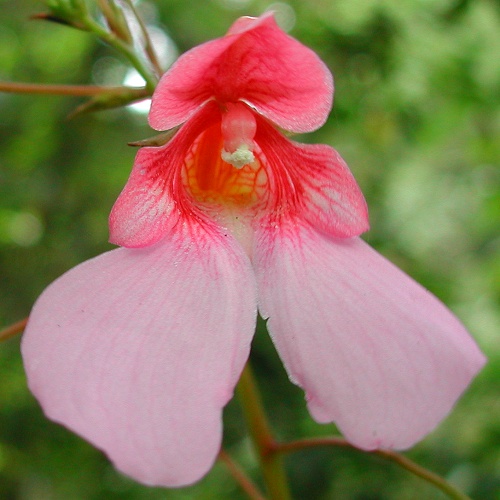| Home |
Strange Wonderful Things Rare and exotic plants & seeds |
 |
|---|
Impatiens flanaganae
Please unpack your plant carefully
Pot size -- The tuber will multiply very quickly and will eventually need a pot at least 8" wide, and preferably 10". However, you may start your tuber in a 5-6" wide pot and transplant it 2-3 months later if you wish. The final pot should be at least 7" tall.
Soil -- Like most Impatiens, this one likes moist, rich, well-draining soil. Most high-quality potting soils should work, although it's a good idea to mix in some perlite (1/4 volume) to lighten the mix and let it drain better.
Climate -- The preferred temperature range is between 40 and 80 or 85 degrees. If the plant lags in hot weather, you might need to bring it into an air conditioned, humidified room. You can grow it indoors, provided that the air isn't too dry. If your room humidity is under 40%, consider using an ultrasonic room humidifier, which you can buy at places like Home Depot and thrift shops. Outdoors, the dormant tubers are hardy down the low-20s if planted deep, although it's probably best to bring the pot indoors.
Watering -- Your plant likes evenly-moist conditions, but it shouldn't stay perpetually soggy. Be careful not to let the soil dry out. You can put a layer of mulch on the soil to retain moisture and keep the roots cool.
In many parts of the country, the water supply has unwanted chemicals or a high pH. If you have doubts about your water, use bottled water or rain water. Avoid water-softening filters that add sodium to the water, like Brita or Pur.
Lighting -- This Impatiens does best in filtered light. Prolonged direct sun might burn it, unless it's morning or late afternoon sun. In warmer areas, keep it well shaded during mid-day. Keep the pot shaded too, for the same reason.
Fertilizing -- Your Impatiens likes average amounts of fertilizer. Feed about every 3 weeks during periods of active growth using regular all-purpose fertilizer that has micronutrients. It's normal for an older leaf to occasionally turn yellow and drop, but if it's excessive, the plant may need more fertilizer, particularly nitrogen.
Dormancy care -- The plant usually, but not always, goes dormant in winter, at least outdoors. If it does, ensure that the soil does not dry out. If you pull the bulbs up to separate them, place them back into moderately moist soil, so they do not dry out. The bulbs are fairly rot-proof, but avoid letting the soil get too wet. Indoors, the plants can stay evergreen year-round.
Pests to watch for -- Scale (little brown disks on the stems - very hard to see!), aphids, spider mites (tiny "dots" under the leaves), whitefly.
If you have any questions, feel free to email me.
Good luck with it!
Jeff
Strange Wonderful Things
| Home |
Strange Wonderful Things Rare and exotic plants & seeds |
|
|---|---|---|
| Entire site Copyright 2004-2016 by Strange Wonderful Things, except as noted | ||

